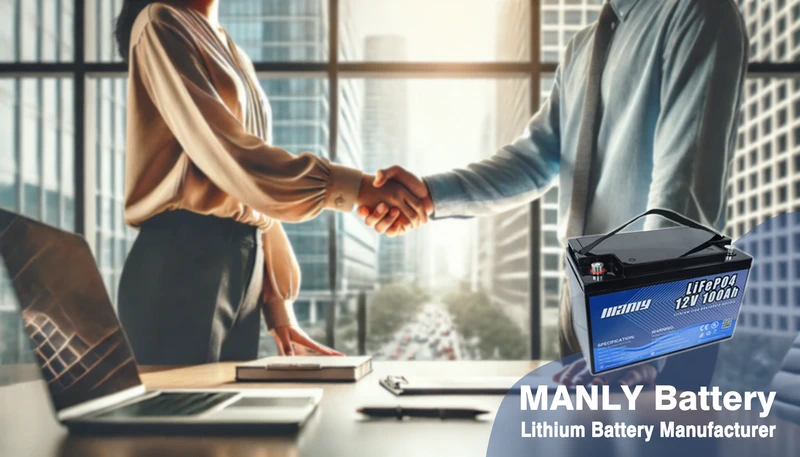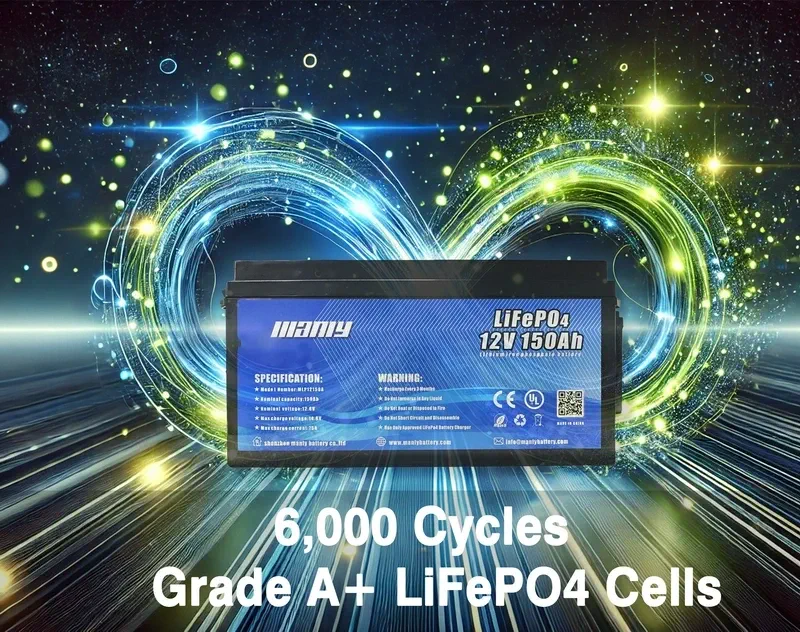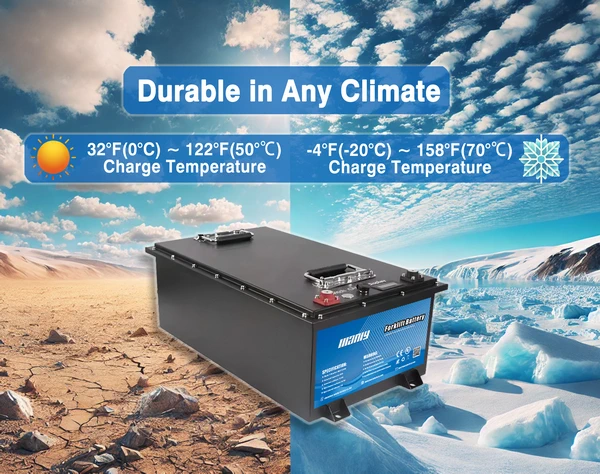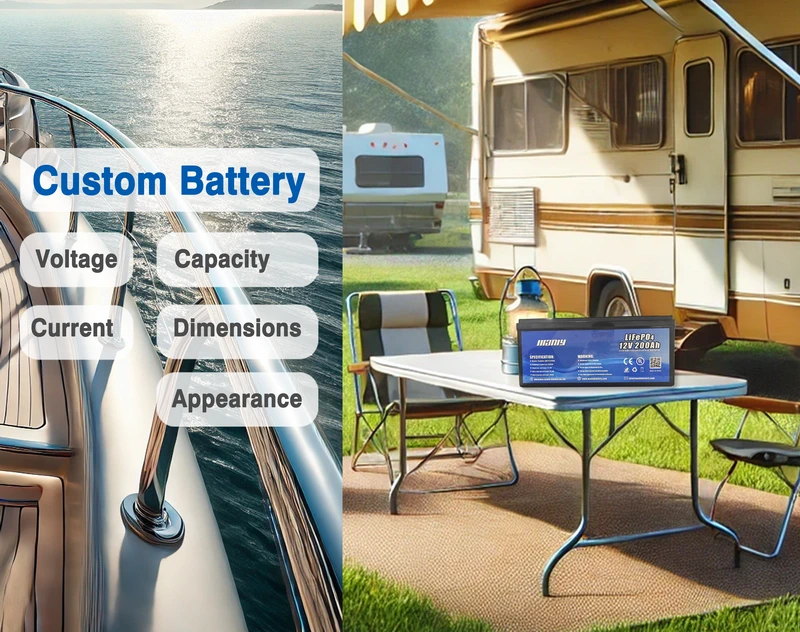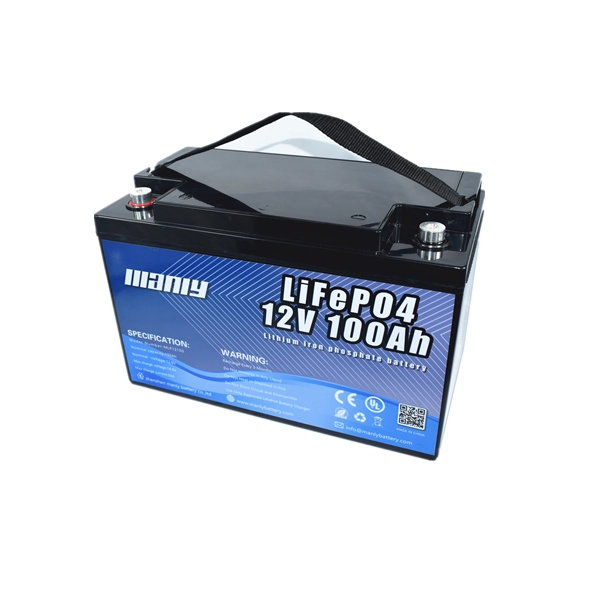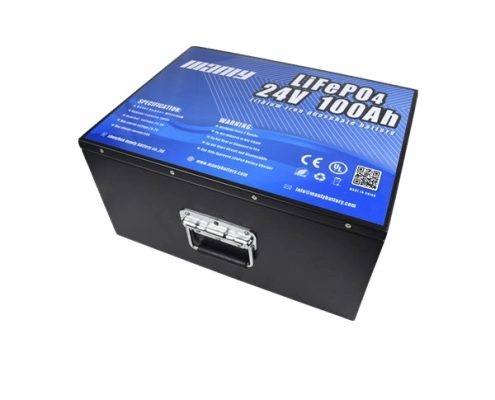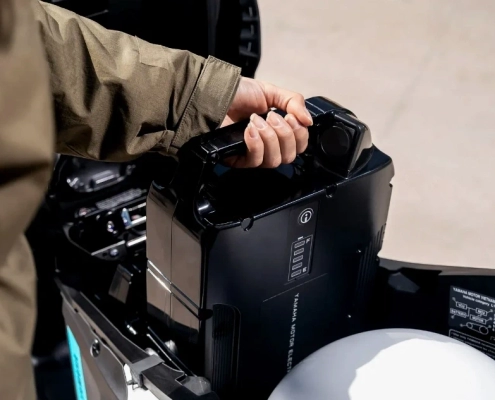Experteneinblicke zur besten LiFePO4-Batterie des Jahres 2025
Inhaltsverzeichnis
- Experteneinblicke zur besten LiFePO4-Batterie des Jahres 2025
- Was ist eine LiFePO4-Batterie?
- Lohnt sich die LiFePO4-Lithium batterie wirklich?
- Kurzanleitung: Auswahl der besten LiFePO4-Batterie
- Die 6 besten LiFePO4-Batteriemarken
- Die beste LiFePO4-Batterie zur Auswahl
- Beste LiFePO4-Batterien für den Schiffseinsatz: Vor- und Nachteile
- Was Sie bei der Auswahl einer LiFePO4-Batterie beachten sollten
- Erfahren Sie mehr über Batterie
Seit Jahrzehnten gibt es zwei Hauptbatterieoptionen. Blei-Säure-Batterien und Standard-Lithium-Batterien sind die bevorzugte Wahl für verschiedene Anwendungen und es gibt sie in allen Formen, Größen, Leistungen und Kapazitäten. Allerdings entwickelt sich die Batterietechnologie ständig weiter. Dies hat damit zu tun, dass sich unsere Elektronik weiterentwickelt und unterschiedliche Batterieeigenschaften benötigt, um ordnungsgemäß zu funktionieren, sowie mit dem allgemeinen Wunsch, langlebigere, billigere und sicherere Energiequellen zu schaffen, die diese Entwicklung vorantreiben.
Wenn Sie sich kürzlich die Batteriewelt angesehen haben, haben Sie wahrscheinlich eine neue Option namens LiFePO4 gesehen. LiFePO4-Batterien gewinnen im Bereich der Lithium batterien schnell an Bedeutung und bieten eine Reihe von Vorteilen, die Sie mit herkömmlichen Lithium-Ionen-Batterien einfach nicht haben.
Wir gehen also darauf ein, was ein LiFePO4 Akku ist, welche Vor- und Nachteile er hat und natürlich welche der besten LiFePO4 Akkus es gibt, damit Sie sicherstellen können, dass Sie einen kostengünstigen, zuverlässigen und zuverlässigen Akku erhalten. und hochwertiges Produkt, wenn Sie diese neueren Batterien ausprobieren.
Lass uns anfangen.
Was ist eine LiFePO4-Batterie?
Eine LiFePO4-Batterie ist eine Art Lithium batterie, die die herkömmliche chemische Lösung, die den elektrischen Strom in Lithium batterien erzeugt, verändert. Während eine herkömmliche Lithium-Ionen-Batterie Lithiumeisenphosphat, Lithiummanganoxid, Kobalt und einen Lithiumsalzelektrolyten enthält, verfügen LifePO4-Batterien über einen Lithiumsalzelektrolyten, Lithiumeisenphosphat und eine Kohlenstoffanode.
Das scheint ein kleiner Unterschied zu sein, aber er hat eine große Wirkung.
Während LiFePO4-Batterien etwas teurer sind, eine geringere Kapazität pro Zelle haben und mehr wiegen, sind sie auch sicherer, halten bis zu sechsmal länger und ihre starke Nutzung in netzunabhängigen Wohnräumen, Solarstromanlagen und ähnlichen Anwendungen macht die meisten davon zunichte ihre Nachteile.
Sie werden sogar billiger, da sie von mehr Herstellern hergestellt werden und die Nachfrage effektiver befriedigt wird.
Lohnt sich die LiFePO4-Lithium batterie wirklich?
Bei Batterien geht es um mehr als nur den Erstkauf. Am besten wäre es, wenn Sie die Langlebigkeit, Effizienz und Gesamtkosteneffizienz berücksichtigen würden. Hier kommen LiFePO4-Batterien ins Spiel, die für viele eine bahnbrechende Wahl sind.
Unschlagbare Vorteile von LiFePO4-Batterien:
- Verlängerte Lebensdauer und hohe Zyklen: Mit einer Lebensdauer von über einem Jahrzehnt sind LiFePO4-Batterien darauf ausgelegt, den Test der Zeit zu bestehen. Stellen Sie sich eine Batterie vor, die über 4.000 Zyklen bietet, einige Premium-Modelle sogar bis zu 7.000!
- Kompakt und leicht: Größe spielt eine Rolle, insbesondere bei Anwendungen, bei denen Platz ein Luxus ist. LiFePO4-Batterien sind im Vergleich zu herkömmlichen Blei-Säure-Batterien nicht nur leichter, sondern auch kompakter.
- Auf lange Sicht kostengünstig: Lassen Sie sich nicht von der Anfangsinvestition abschrecken. Wenn man ihre Langlebigkeit berücksichtigt, liegen diese Batterien in puncto Wirtschaftlichkeit an der Spitze.
- Schnelles Laden und Entladen: In der heutigen schnelllebigen Welt ist es nicht praktikabel, stundenlang auf eine Aufladung zu warten. Diese Batterien erfüllen diesen Bedarf, indem sie schnelles Laden und Entladen unterstützen.
- Tiefere Entladung: Mit über 80 % Entladetiefe (DOD) und einigen sogar mit 100 % Unterstützung sorgt der LiFePO4-Lithium-Akku dafür, dass Sie das Beste aus jeder Ladung herausholen.
- Keine Memory-Effekte: Verabschieden Sie sich von den Leistungseinbußen, die bei vielen Batterietypen auftreten. LiFePO4 behält seine effiziente Leistung durchgehend bei.
- Minimale Selbstentladung: Diese Batterien sind ideal für die Lagerung und verfügen über eine Selbstentladungsrate von nur 3 % pro Monat, wobei sie mehrere Monate lang die Hälfte ihrer Ladung behalten.
- Sicher und umweltfreundlich: Sicherheit geht vor! LiFePO4-Batterien aus umweltfreundlichen Materialien verfügen außerdem über stabile chemische Eigenschaften und sind daher äußerst sicher.
- Geringer Wartungsaufwand: Einmal eingestellt, denken Sie daran. Diese Batterien erfordern sehr wenig Aufmerksamkeit, lediglich regelmäßige Kontrollen auf Oxidation der Anschlüsse und lockere Verkabelung.
- Funktioniert gut bei hohen Temperaturen: Wenn Ihre Anwendung höhere Temperaturen erfordert, können Sie sich darauf verlassen, dass LiFePO4-Batterien der Hitze standhalten.
Abwägen der Vor- und Nachteile:
Ja, LiFePO4-Batterien sind anfänglich mit höheren Kosten verbunden, aber ihre zahlreichen Vorteile machen sie zu einer lohnenden Investition. Ihre beispiellose Effizienz und ihr leichtes Design machen sie zu einer attraktiven Wahl für viele Anwendungen, von medizinischen Geräten bis hin zu Elektrofahrzeugen. Ihre langfristigen Kosteneinsparungen, die sich aus weniger Ersatzteilen und verbesserter Leistung ergeben, übertreffen bei weitem die Vorabausgaben.
Abschließende Gedanken:
Wenn Sie über Ihre nächste Energielösung nachdenken, denken Sie bitte über die reinen Anschaffungskosten hinaus. Die überragende Langlebigkeit, verbesserte Leistung und Umweltvorteile von LiFePO4-Batterien machen sie zu einem Spitzenreiter. Ob für den persönlichen Gebrauch oder für geschäftliche Anwendungen, diese Batterien versprechen zuverlässige Leistung und sind somit eine unschätzbare Ergänzung unserer sich ständig weiterentwickelnden Technologielandschaft.
Kurzanleitung: Auswahl der besten LiFePO4-Batterie
Bereit zum Kauf einesLiFePO4 Akku? Großartig! Aber warten Sie, Sie wollen das Beste, oder? Hier ist eine einfache Liste, die Ihnen helfen soll:
- Wie viel Leistung?Könnten Sie die Amperestundenzahl auf dem Etikett überprüfen? Es gibt an, wie viel Strom der Akku speichern kann und wie lange er Ihre Geräte betreiben kann.
- Spannungsangelegenheiten: Stellen Sie sich Spannung wie Puzzleteile vor. Eine 12-V-Batterie passt nicht in ein 24-V-System. Passen Sie die Batterie immer an die Spannung Ihres Systems an.
- Zyklus-Leben: Stellen Sie sich vor, einen Akku wiederholt aufzuladen und zu verwenden. Je mehr Zyklen es verträgt, desto länger hält es. Das ist ein gutes Preis-Leistungs-Verhältnis!
- Echte Leistungsabgabe: Eine Batterie sagt vielleicht 100 Ah aus, liefert aber im echten Leben vielleicht nur 90 Ah. Achten Sie auf die Entladungstiefe, um die wahre Leistung zu ermitteln.
- Schnelles Aufladen: Manche Akkus werden schneller aufgeladen und verbrauchen dabei weniger Energie. Das nennt man Ladeeffizienz. Höher ist besser!
- Passt perfekt: Batterien gibt es in verschiedenen Formen und Größen. Stellen Sie sicher, dass es dort passt, wo Sie es brauchen, sei es für ein Boot oder eine Solaranlage.
- Bleib sicher: Gute Batterien habenSicherheitsvorrichtungen. Achten Sie auf Dinge wie Schutz vor Kurzschlüssen oder Überladung.
- Garantie erzählt: Eine lange Garantie bedeutet oft, dass der Akku hochwertig ist. Sechs Monate? Meh. Fünf Jahre? Das ist Vertrauen!
- Preis vs. Wert: Billiger ist manchmal besser. Überlegen Sie, wie lange die Batterie hält. Manchmal spart eine etwas höhere Vorauszahlung auf lange Sicht Geld.
- Vertrauenswürdige Marken: Bekannte Marken bedeuten in der Regel bessere Qualität und Service. Es ist, als würde man zwischen einer beliebigen Limonade und der Lieblingsmarke wählen.
- Was sagen die Leute?: Überprüfen Sie Online-Bewertungen. Wenn viele Leute mit einer Batterie zufrieden sind, sind Sie vielleicht auch zufrieden!
Die 6 besten LiFePO4-Batteriemarken
In der sich schnell entwickelnden Welt der Energie und Technologie ist die Batterieindustrie ein Eckpfeiler, der alles antreibt, von der täglichen Unterhaltungselektronik bis hin zur nächsten Generation von Elektrofahrzeugen (EVs) und Speicherlösungen für erneuerbare Energien. An der Spitze dieses transformativen Sektors stehen sechs Unternehmen, die die Landschaft der Batterietechnologie geprägt haben und weiterhin die Grenzen von Innovation, Nachhaltigkeit und Effizienz verschieben. Diese Vorreiter – Tesla, Inc., Panasonic Corporation, Samsung SDI, LG Chem, BYD Company Ltd. und MANLY Battery – bringen jeweils ihre einzigartigen Stärken, technologischen Fortschritte und strategischen Visionen ein und treiben gemeinsam die Branche voran.
1. Tesla, Inc. und seine Partnerschaft mit Panasonic
Tesla, Inc., ein führendes Unternehmen im Bereich Elektrofahrzeuge (EV) und Energie, war maßgeblich an der Einführung nachhaltiger Energielösungen beteiligt. Ein Schlüsselelement für den Erfolg von Tesla bei diesen Unternehmungen war die Partnerschaft mit Panasonic, einem renommierten Elektronik- und Batteriehersteller. Diese Zusammenarbeit war von zentraler Bedeutung für die Strategie von Tesla, insbesondere im Bereich der Batterieproduktion für seine Elektrofahrzeuge und andere Automobilkunden.
Anpassung an die Marktdynamik
Recent developments have seen Panasonic revising its full-year operating income forecast for its battery segment, which primarily serves Tesla and other automotive companies, from 135 billion yen down to 115 billion yen (approximately $769 million). This adjustment reflects the company’s response to a swiftly changing market demand, necessitating a recalibration of automotive battery production volumes in Japan to maintain “appropriate inventory levels.”
The backdrop to this scenario involves the implementation of the U.S. Inflation Reduction Act (IRA), which has significantly influenced consumer demand patterns. The Japanese battery sector, including Panasonic’s operations, has felt the impact of a slowdown in demand for high-end EVs in North America. Despite this, Panasonic’s North American business has maintained stable production, buoyed by robust sales of vehicles that qualify for tax credits under the IRA, illustrating a nuanced landscape of challenges and resilience.
Financial Performance and Strategic Moves
Panasonic’s energy division reported revenue of 119.2 billion yen, marking a 4.7% year-on-year increase, though it experienced a 6.4% sequential decrease. Power batteries accounted for 85.1 billion yen in revenue in this segment, with storage/consumer batteries contributing 33.4 billion yen. Remarkably, the battery business’s operating profit stood at 15.1 billion yen, boasting an operating profit margin of 12.37%, with an 81.0% year-on-year increase and a significant 586.1% jump sequentially.
This financial uptick is primarily attributed to the growing demand for power batteries, enhanced productivity, and the amplification provided by IRA tax credits. Panasonic Energy has recognized a net profit of 26.8 billion yen from IRA tax credits, anticipating eligibility for AMPC subsidies to expedite capacity building in the U.S., with expectations of securing billions of yen in subsidies.
Forging Ahead
Tesla’s partnership with Panasonic underscores a mutual commitment to advancing EV technology and energy storage solutions. Despite market fluctuations and regulatory changes, this alliance remains a testament to the dynamic nature of the sustainable energy sector. Through strategic adjustments and leveraging legislative incentives like the IRA, Tesla, and Panasonic continue to pave the way for a future powered by clean, renewable energy, demonstrating adaptability and forward-thinking in a rapidly evolving industry landscape.
2. Panasonic Corporation
Panasonic Corporation, a global electronics and energy giant, has made notable adjustments in its financial forecasts and production strategies, reflecting the dynamic nature of the automotive battery market and the broader energy sector. The company, renowned for its innovation in battery technology, particularly for electric vehicles (EVs), including its collaboration with Tesla, has navigated the challenges and opportunities presented by fluctuating market demands and policy shifts, such as the U.S. Inflation Reduction Act (IRA).
Financial Revisions and Market Adaptation
In a significant move, Panasonic revised its full-year operating income expectation for its energy division, which is a crucial supplier for Tesla and other automotive manufacturers. The projection was adjusted from 135 billion yen to 115 billion yen (approximately $769 million). This revision was a strategic response to the rapidly changing demand within the automotive battery sector, prompting the company to adjust its production volumes in Japan. The aim was to maintain an “appropriate inventory level” amid decreasing demand, a challenge accentuated in the period leading up to September.
Impact of the Inflation Reduction Act
The IRA has played a pivotal role in shaping consumer demand within the U.S., affecting the production dynamics of Panasonic’s battery division. While high-end EV demand in North America experienced a slowdown, impacting Panasonic’s Japanese battery production, the company managed to keep its North American operations steady. This stability was supported by robust sales of vehicles eligible for tax credits under the IRA, illustrating Panasonic’s ability to adapt to market shifts and leverage policy changes to its advantage.
Financial Performance and Strategic Investments
Panasonic Energy reported a revenue of 119.2 billion yen, marking a year-on-year increase of 4.7%, despite a sequential decline of 6.4%. The revenue from power batteries stood at 85.1 billion yen, with storage/consumer batteries contributing 33.4 billion yen. Notably, the battery business’s operating profit reached 15.1 billion yen, achieving an impressive operating profit margin of 12.37%. This represents an 81.0% increase year-on-year and a significant sequential surge of 586.1%.
The remarkable financial performance can be attributed to the growing demand for power batteries, enhanced productivity, and the beneficial impact of IRA tax credits. Panasonic Energy recognized a net profit of 26.8 billion yen from these tax credits, anticipating eligibility for AMPC subsidies. These subsidies are expected to accelerate Panasonic’s capacity building efforts in the U.S., potentially securing billions of yen in support.
Looking Forward
Panasonic Corporation’s strategic adjustments and financial performance underscore its resilience and adaptability in a rapidly evolving industry. The company’s focus on leveraging policy incentives, such as the IRA, and its commitment to innovation and sustainability, position Panasonic as a key player in the global transition towards clean energy. As the demand for electric vehicles and renewable energy solutions continues to grow, Panasonic’s expertise in battery technology and strategic investments will play a crucial role in shaping the future of energy storage and mobility.
3. Samsung SDI
Samsung SDI, a leading player in the global battery industry, announced its performance for the year 2023 on January 30, 2024. The company reported a record-breaking sales revenue of 22.71 trillion Korean won, marking an increase of 2.58 trillion won compared to 2022, thus achieving the highest sales performance in its history. However, its operating profit saw a decrease of 1.746 trillion won. The automotive battery business, in particular, experienced significant growth, with sales revenue increasing by 40% and operating profit by 93% compared to the previous year.
Quarterly Performance Insights
In the fourth quarter of 2023, Samsung SDI’s sales amounted to 5.56 trillion Korean won, with an operating profit of 311.8 billion won. This represents a decrease in sales revenue by 401.1 billion won, and a reduction in operating profit by 179 billion won compared to the same period in 2022. When compared to the third quarter of 2023, both sales revenue and operating profit saw declines, indicating a challenging quarter for the company.
During the fourth quarter, the battery division’s sales were 4.9983 trillion Korean won, a decrease from both the same period in 2022 and the third quarter of 2023. Operating profit for this period also fell, underlining the competitive and volatile nature of the global battery market.
Outlook for 2024
For 2024, Samsung SDI is optimistic, projecting the power battery market to reach approximately $184.8 billion, representing an 18% growth over the previous year. The company plans to enhance its sales and profitability by expanding the sales of high-end products like P5 and P6. It is also gearing up to secure new platform orders and ensure smooth operations at its new facility in the United States.
In the energy storage battery market, Samsung SDI anticipates a similar growth rate of 18%, expecting the market to hit $25.6 billion. While continued growth is expected in major markets like North America, Europe, and China, emerging demand from South Korea and South America is projected due to the development policies in the energy storage industry. Samsung SDI aims to capture new orders with innovative products like SBB (Samsung Battery Box) and is preparing LFP (Lithium Iron Phosphate) products to meet market demand effectively.
Moreover, the small battery market is forecasted to grow by 3% in 2024, reaching $43.8 billion. Despite a stagnation in overall demand for electric tools, Samsung SDI anticipates increased demand for specialized applications driven by product diversification and higher electrification rates due to environmental regulations.
Samsung SDI’s strategic focus on expanding its product portfolio, entering new markets, and leveraging technological advancements positions the company to successfully navigate the complexities of the global battery market. With its commitment to innovation and sustainability, Samsung SDI is poised to play a crucial role in powering the future of mobility and energy storage solutions.
4. LG Chem
LG Chem, a conglomerate rooted deeply in the realms of petrochemicals, batteries, advanced materials, and life sciences, envisions a future where energy, water, and biology are the pillars of new business growth. The company’s commitment to enhancing human life through innovative materials is evident in its leadership aspirations in the eco-friendly energy industry, particularly by developing next-generation battery technologies and materials.
Innovation at the Forefront
LG Chem’s strategy is anchored in spearheading the global lithium battery market with its cutting-edge material technologies. The firm sets its sights on becoming a global leader in the electric vehicle (EV) and energy storage system (ESS) battery sectors. By laying a foundation of innovative technological prowess, LG Chem actively pursues new product development, ensuring world-class battery production capabilities and enhancing its market share in the next-generation renewable energy market.
Market Dynamics and Financial Performance
Recently, LG Chem’s new energy sector, focused on batteries, encountered a downturn, with profits in the fourth quarter showing a significant dip of 53.7% quarter-over-quarter. This decline is attributed to the sluggish demand for EVs in Europe, cautious inventory management by automotive manufacturers, and the continuous decrease in metal prices. Despite these challenges, global growth in the EV battery market is expected to decelerate temporarily: the global EV market is anticipated to grow by around 20% this year, with North America projected to maintain a growth rate of approximately 30%.
Looking Ahead to 2024
LG Chem’s outlook for 2024 is cautiously optimistic, with revenue growth projected to be in the mid-range of 0% to 10%. The company is strategically positioned to benefit from the U.S. government’s tax incentives, expecting its 45–50 GWh capacity to qualify for tax credits. This anticipation aligns with LG Chem’s broader strategy to leverage policy incentives to bolster its competitive stance in the rapidly evolving energy market.
LG Chem’s journey reflects a blend of innovation, strategic market positioning, and adaptability to global market trends and regulatory landscapes. By focusing on innovative materials and battery technologies, LG Chem aims to lead in the EV and ESS domains and contributes significantly to the global transition towards sustainable energy solutions.
Die beste LiFePO4-Batterie zur Auswahl
Currently, LiFePO4 batteries are relatively new, so only some batteries suppliers have jumped on the bandwagon and started making them. However, a few of the suppliers that have started producing them stand out as great options for various reasons. We’re going to start with our top pick, and then we’ll go over a few honorable mentions.
1: MANLYs beste LiFePO4 12v 200ah Batterie
This is our top recommendation, and for practically anything you’d want to use a 12v battery for, it’s going to be the best you can get.
MANLY has several traits working to its advantage:
First, there’s the 200ah rating. The vast majority of 12v batteries max out at 100ah. This allows the MANLY battery to discharge 200 amps of electricity for an hour before the battery depletes. It’s unlikely that most devices will need that, but it more or less equates to more capacity overall and better flexibility.
However, that’s not the only thing that sets the MANLY battery apart. It has several features and traits that make it the best LiFePO4 battery 12v 200ah.
First, there’s the built-in safety features. MANLY packs its batteries with overcurrent protection, undercurrent protection, short circuit protection, and temperature-based protection to ensure that you get the safest battery possible. Along with LiFePO4’s innate high level of safety, these safety features basically eliminate any concerns for fire hazards or unnatural battery failures; along with any concerns for poor current control damaging the items they’re hooked up to.
Then, there’s the advanced performance. MANLY batteries maintain their performance and capacity at 90% throughout their lifespan. They also charge a lot faster than the competition, and they provide reliable performance for roughly 8000 charging cycles before it’s recommended to replace them. This means that, even if the MANLY isn’t the cheapest up front, it’s still the best value in the long haul.
In terms of the battery itself, the final main benefit is that MANLY provides customized battery options to suit any need. So, if the off-the-shelf battery isn’t exactly what you need, you can place a custom order.
The battery supplier itself also offers a top-tier guarantee, 24/7 service, and a long-standing reputation across the entire planet. You can’t underestimate the value of great after-purchase care and customer support; especially given the demanding applications these batteries are used for.
2: SOK 12v 206ah Solarspeicher
The SOK boasts many of the same specs as the MANLY, but it’s not as advanced with its safety features and focuses primarily on providing a stable battery for residential solar power storage. In short, it’s a great battery if you have at-home solar panels to offset your energy bill or keep your home powered during emergencies.
The casing also boasts a significant level of quality. SOK knows that residential homes are often prone to experiencing mishaps and issues. So, there’s extra care taken to make sure the battery is solid. You don’t have to worry about your kids banging on it, the dog ripping it out of its space, or anything else that can cause dangerous situations to occur.
However, the battery only features a limited 5-year warranty, and it’s priced above our top pick with less flexibility.
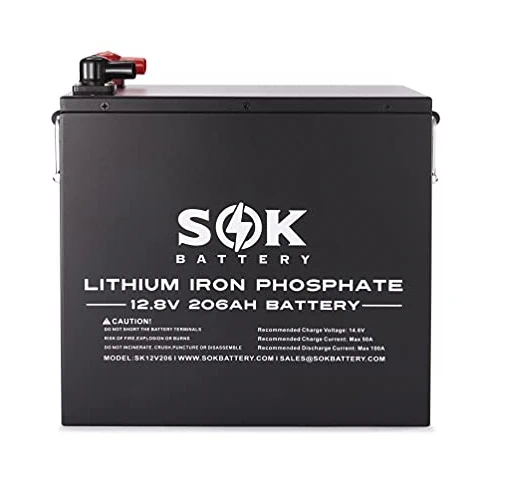
3: Lion UT 1300
The Lion UT 1300 boasts an incredible ampere, but it has a more limited battery as well.
With 1300ah, a lightweight design, and a smaller profile than expected, the Lion UT 1300 is a great option for on-the-go charging; whether you’re off-grid and need to power your comms, or you’re just at a worksite all day and need to keep your phone and smaller tools charged.
This is where the UT 1300 excels; as a personal charger for smaller electronics.
This is both a great design choice and a drawback.
Sure, you can use this as an amazing power bank for personal electronics, but if you want to operate complex items with it, such as powering your fridge during a power outage or running shop tools without having your shop attached to the grid, it’s not going to work.
It is priced appropriately, though. So, this is something that works great if you’re going camping for the weekend, work long hours, and need to charge your electronics, or something like that.
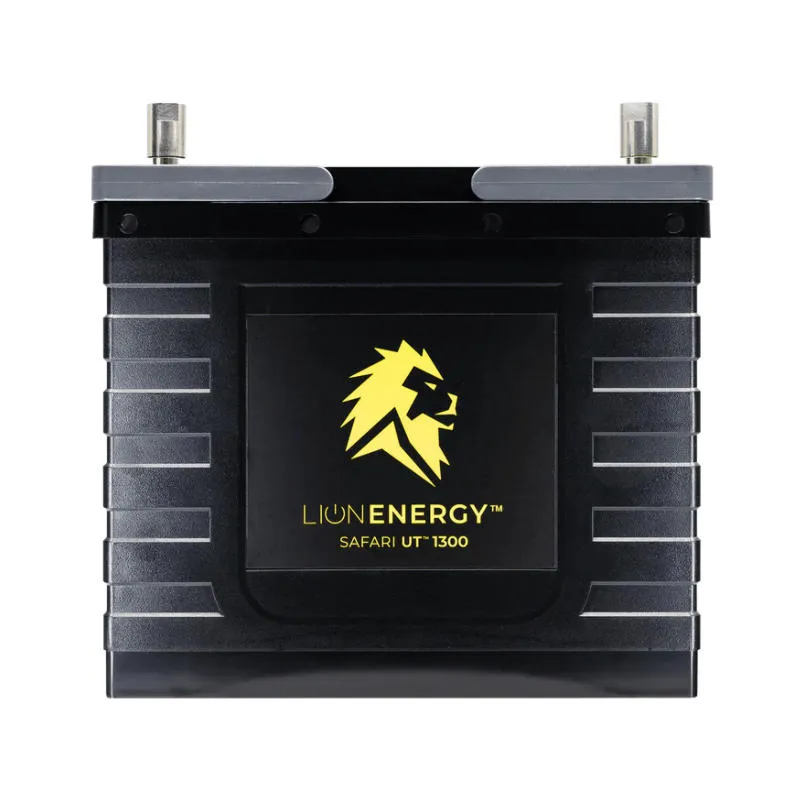
4: Battleborn 100-Ah-Solarbatterie für Privathaushalte
This is another highly specific battery. It doesn’t try to get everything right for every situation, but it does try to be the best for residential solar power needs, and it does a great job.
The Battleborn 100ah is a LiFePO4 battery that has the standard 100ah rating, and it’s entirely designed around storing solar power and using it efficiently to power a home. That is great if you’re going to use it for a solar power system, but it produces several faults when you try to use it for other uses. Notably, its 100ah rating means that it can only use 100 amps in an hour, or it’ll deplete its entire charge.
However, it does provide 10,000 watts of power per charge, and that can help you keep the lights on, the fridge running, and your phone charged during a power outage. You just don’t want to try to run your entire house the same way you would if the grid were working properly.
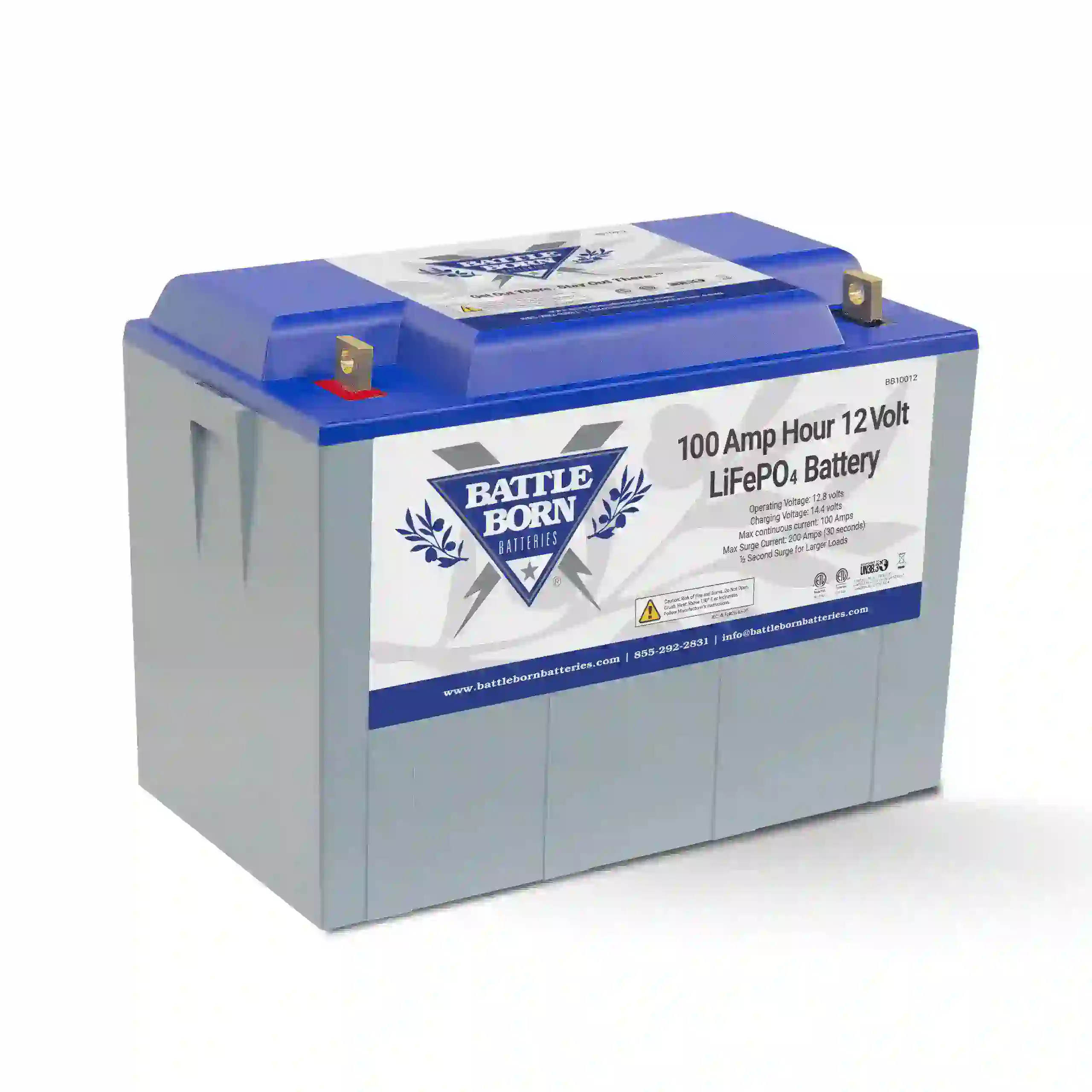
5: UMWELTFREUNDLICHE 12-V-150-Ah-LiFePO4-Batterie
The ECO WORTHY battery is another excellent choice, especially for those who need a lightweight and portable power solution. This 12V 150Ah LiFePO4 battery is designed for long-lasting use, capable of more than 3,000 cycles—four times more than traditional 100Ah lead-acid batteries. The ECO WORTHY battery retains 80% of its capacity even after extensive use, providing reliable power over time.
Weighing only 36.68 pounds, this battery is easy to carry and install, making it perfect for outdoor activities and indoor setups alike. It can be fully charged within a day using a 400W to 600W solar kit, generating between 1.6 to 2.4 kWh daily. For those needing more power, this battery can be expanded in series or parallel, allowing flexibility to meet your energy needs.
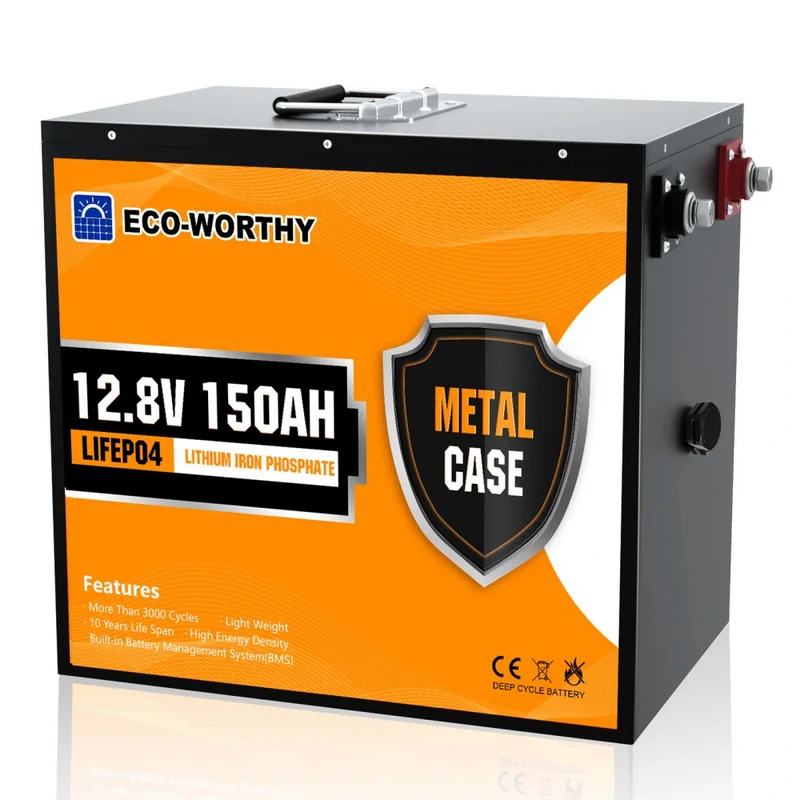
6: CHINS 12 V 100 Ah LiFePO4-Batterie
The CHINS 12V 100Ah LiFePO4 battery is well-known for its long service life. This battery provides over 2,000 cycles, which is significantly more than the 300 to 500 cycles typically offered by lead-acid batteries. This means that the LiFePO4 battery lasts eight to ten times longer, making it a smart investment for those looking for durability and longevity.
Another advantage of the CHINS LiFePO4 battery is its lightweight design. It is 30% lighter than a lead-acid battery of the same capacity, making it easier to install and transport. This battery is ideal for various applications, including home energy storage systems, UPS backup, digital CCTV cameras, electric vehicles, and more. If you’re looking to power a motorhome, RV, or even a boat, the CHINS LiFePO4 battery is a versatile option that won’t weigh you down.
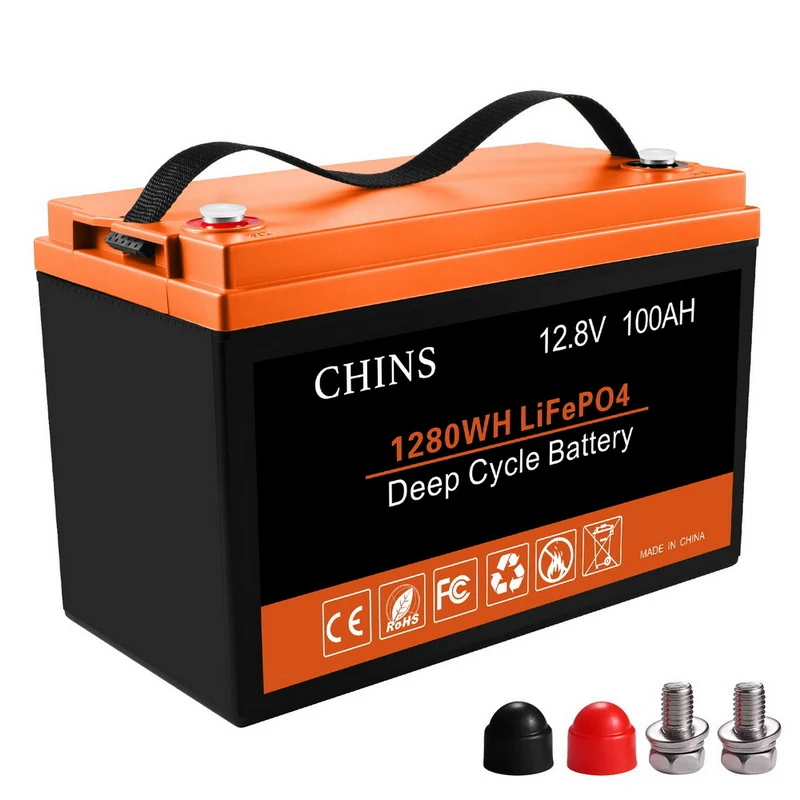
7: Power Queen LiFePO4 Akku
The Power Queen 12V 100Ah LiFePO4 battery is another strong contender, especially if you want a battery with advanced protection features. This battery ensures 100% usable capacity and delivers 1,280Wh of energy output, with an impressive energy density of 57Wh per pound, compared to the market average of 44Wh per pound. This makes it not only efficient but also powerful.
One of the standout features of the Power Queen LiFePO4 battery is its upgraded Battery Management System (BMS). This system protects the battery from common issues like overcharging, over-discharging, short circuits, and overheating, even at temperatures as high as 158°F (70°C). With a lifespan of up to 4,000 cycles and a 10-year expected life, this battery offers both safety and durability.
Additionally, Power Queen backs their battery with a five-year warranty, and customers in the United States benefit from quick delivery due to their local warehouses in California, Texas, and Georgia.
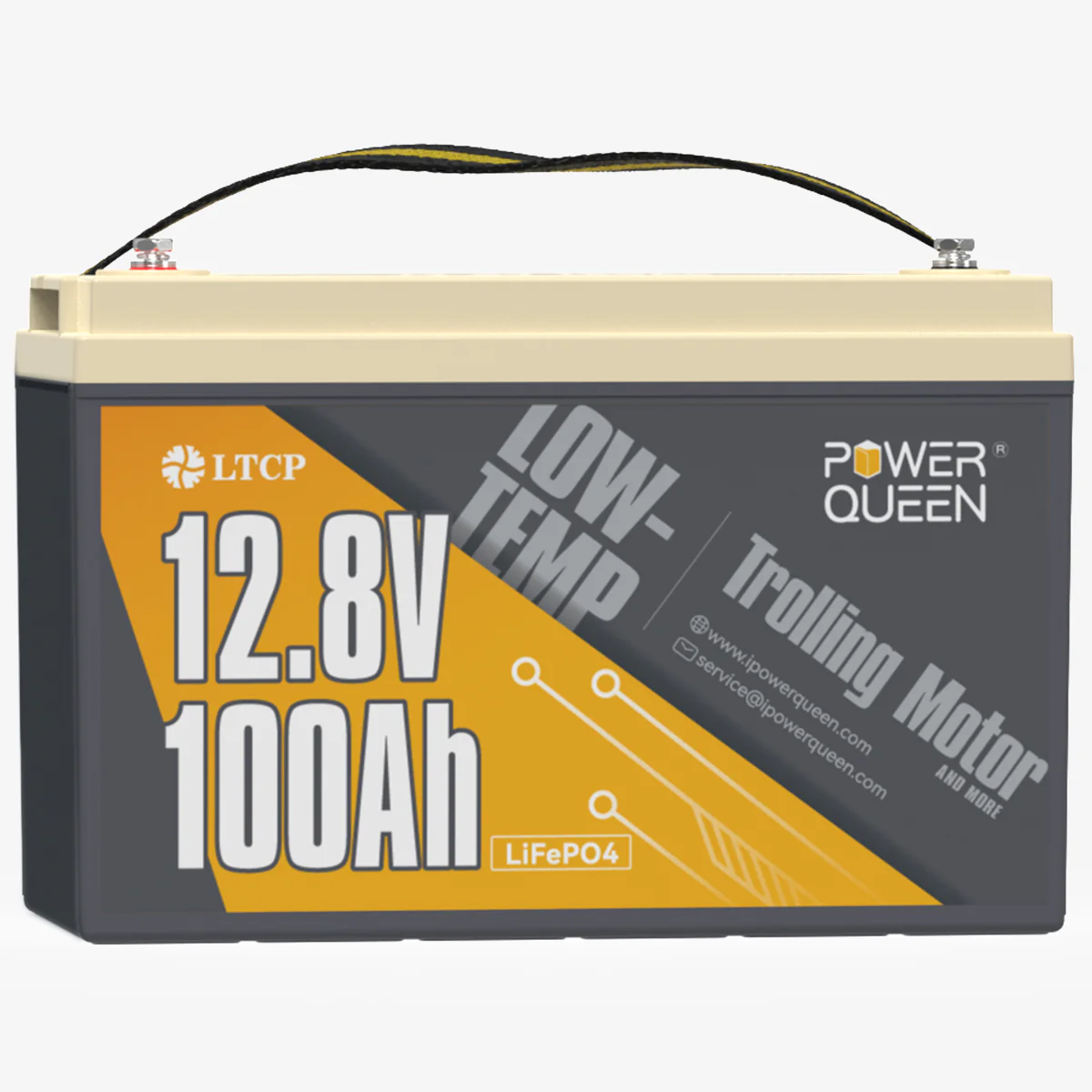
Beste LiFePO4-Batterien für den Schiffseinsatz: Vor- und Nachteile
Navigating the sea of battery options for marine applications can be challenging. Here’s a brief overview of three top LiFePO4 battery choices, each with its unique strengths and potential drawbacks.
MANLY 12V 100Ah Marine-Lithium batterie
Brief Overview:
The MANLY 100Ah lithium battery stands out for its safety and longevity, boasting a life span that’s eight times longer than traditional lead-acid batteries. Designed with advanced LiFePO4 cells, it promises exceptional durability through optimized manufacturing processes. It also includes a sophisticated Battery Management System (BMS) for enhanced protection and compatibility with various inverters.
Vorteile:
- Remarkable longevity and safety features.
- No maintenance required.
- Can be connected up to 4 batteries for extended capacity.
- Includes cold weather protection and an IP66 marine rating.
- Backed by a 10-year warranty.
Nachteile:
- Higher initial investment.
- Longer delivery times to the USA.
WEIZE 12V 100Ah LiFePO4 Akku
Brief Overview:
WEIZE offers an affordable LiFePO4 battery solution without compromising on power. With a lifespan boasting up to 8000 cycles and a lightweight design, it’s an attractive option for boaters looking to upgrade from heavier lead-acid batteries. The built-in BMS safeguards against power surges and extreme temperatures, ensuring reliable performance even in cold weather.
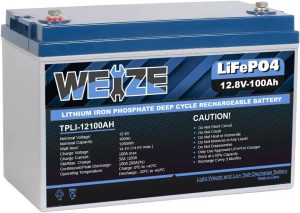
Vorteile:
- Long-lasting with a 10-year warranty.
- Lightweight and easy to install.
- Environmentally friendly and non-toxic.
- Efficient performance in a wide temperature range.
Nachteile:
- Variability in build quality reported.
- Some concerns with customer service responsiveness.
Optima Blue Top-Batterie
Brief Overview:
Optima’s Blue Top battery is the compact solution for marine enthusiasts with limited space. Known for its distinctive design and reliable performance, it can be mounted in nearly any position and is resistant to vibrations. Available in four sizes, it caters to various needs and applications, offering a smaller footprint without sacrificing power.
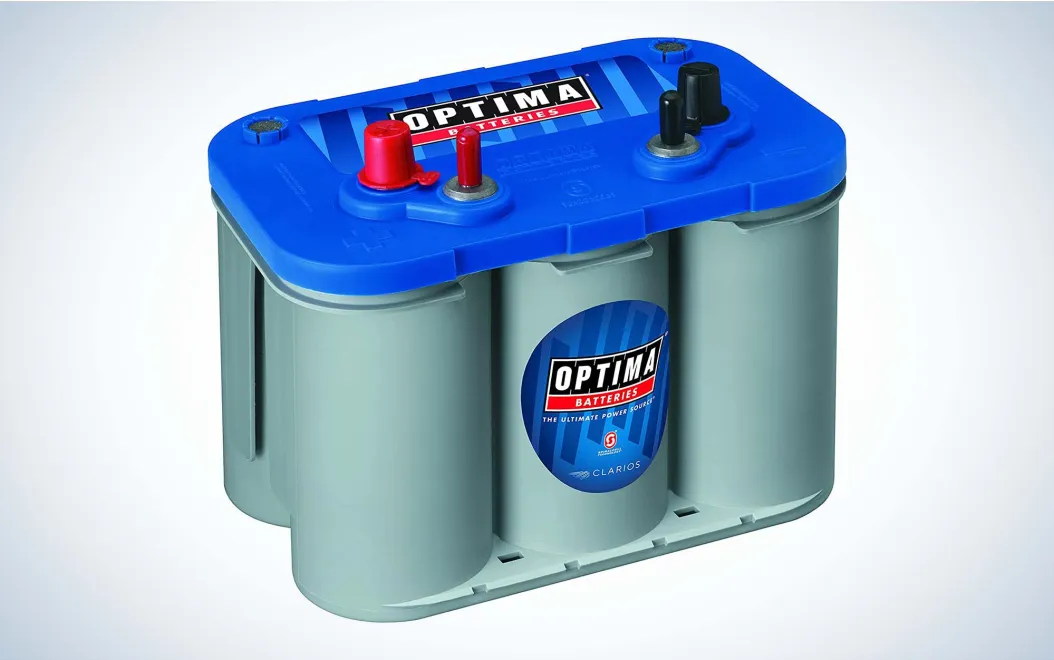
Vorteile:
- Versatile mounting options due to its compact size.
- Vibration resistance adds to its durability.
- Suitable for spaces with limited room.
Nachteile:
- Not the lightest option for its size.
- Premium pricing compared to other batteries on the market.
Abschluss
Whether you prioritize longevity, cost-efficiency, or compact design, there’s a LiFePO4 battery suited to your marine needs. Each option brings something valuable to the table, from the MANLY battery’s unparalleled safety and longevity to WEIZE’s affordability and environmental friendliness, and Optima’s compact, versatile design. Consider your specific needs, budget, and space requirements to make the best choice for your marine adventures.
Was Sie bei der Auswahl einer LiFePO4-Batterie beachten sollten
So, now that you know a few of the top brands, how do you choose between them?
Here are a few things to consider.
1: Die beste Wahl ist im Allgemeinen die beste
Our number-one pick, the MANLY 12v 200ah LiFePO4 battery, is the best all around. It can do the vast majority of things you could possibly ask for, it’s priced attractively, and it has some of the best safety and quality-of-life features possible. It’s also backed by a guarantee that covers the full standard expected life of a LiFePO4 battery.
In the vast majority of situations, the MANLY is going to be your best bet, hands down.
It’s when your needs are extremely targeted, and there are unique traits, that you need to look elsewhere.
MANLY Battery is also a renowned battery supplier that supplies batteries to commercial and consumer markets around the world, and it offers one of the best guarantees around to ensure you’re satisfied.
2: Why MANLY-Batterie Top the Chart: 8 Reasons
- Industry-Leading Manufacturing: With over 13 years in battery production, MANLY Battery sets the standard. Producing up to 6MWh daily, the brand epitomizes quality combined with vast production capacity.
- Diverse Battery Solutions: Searching for solar energy storage batteries or those tailored for military applications? MANLY offers a spectrum of LiFePO4/lithium-ion batteries, catering to diverse energy needs from 6V to 72V.
- Precision Customization: MANLY Battery understands individual requirements, offering bespoke battery services. Whether you’re after a specific voltage, capacity, or aesthetic, they are the go-to for customized battery solutions.
- Globally Certified Excellence: With international certifications like IEC62133, UL, and CE, MANLY ensures you’re investing in globally recognized quality. Their decade-long warranty stands as a testament to their commitment.
- Safety Meets Efficiency: From overcharge protection to resilience against severe impacts, MANLY batteries are synonymous with safety. Plus, their performance metrics ensure they’re not just safe but incredibly efficient.
- All-Weather Battery Power: Where many batteries falter, MANLY thrives. Optimal performance from -20°C to 75°C ensures your adventures continue, irrespective of extreme climatic challenges.
- Eco-friendly Energy Champion: Boasting an impressive 98% energy efficiency, MANLY’s LiFePO4 batteries outclass traditional lead-acid variants, ensuring faster charging and minimized energy consumption.
- Futuristic User Interactions: With features like Bluetooth connectivity and clear battery level displays, MANLY Battery redefines the user experience, offering a seamless blend of power and modern-day tech.
3: Ihre Nutzung
If you have a niche usage, such as a personal power bank to put in your vehicle and charge your electronics, an option like the Lion UT 1300 is worth looking at. However, you wouldn’t want to power your home with it.
Consider your specific usage for the battery, and if it’s very niche, pick a battery designed to fit that purpose.
4: Benötigte Leistung
Finally, you need to look at the voltage, amp hours, and wattage needed to fulfill your needs. Every electronic is different. So, we can’t really list out anything in general. However, with a bit of research, or just looking at a system’s requirements printed on the system, you can find the perfect battery to meet your needs. With more complex usages, you should expect to do a little research.

